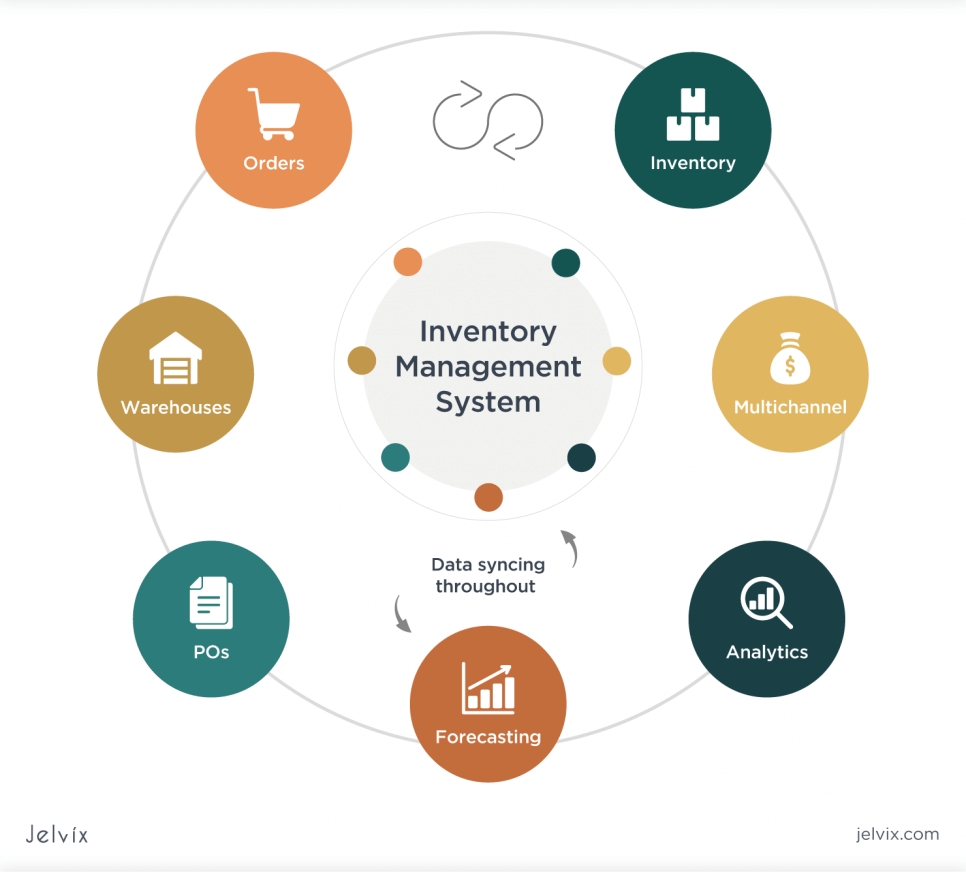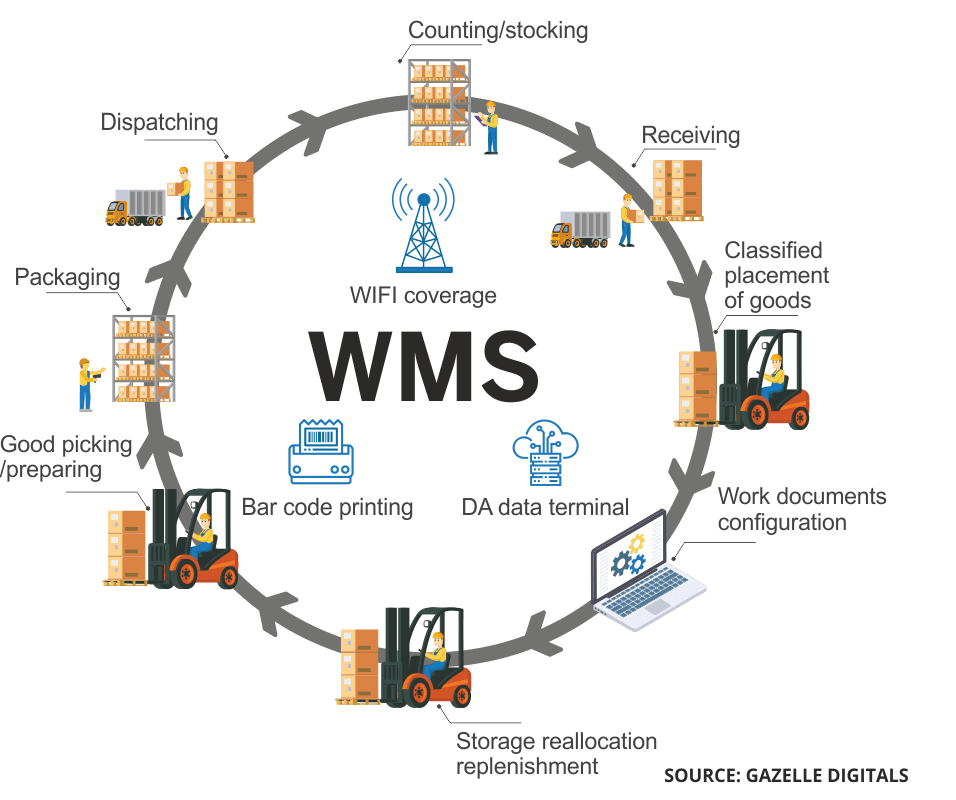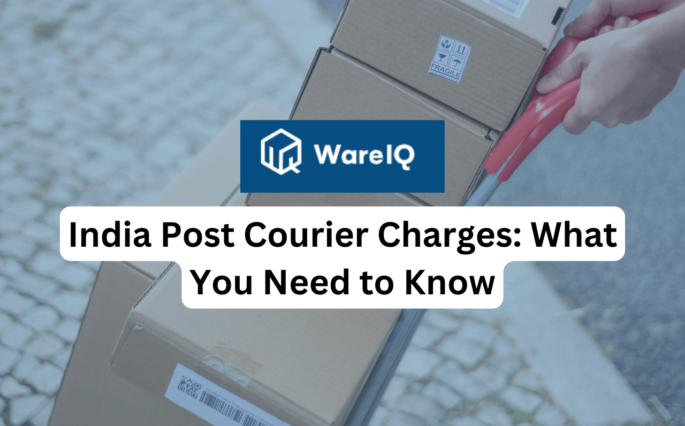Warehouse Management Vs Inventory Management: Which Software Solution Suits Your Business Operations The Best in 2025?

According to Statista, the market for supply chain management was estimated to be worth 15.85 billion US dollars in 2020, and by 2026, it is anticipated to be close to 31 billion.
The mainstay of manufacturing and distribution companies has been and will always revolve around warehouse and inventory management. Effective inventory management is essential because it impacts everything from warehouse operations and shelf availability to loss prevention, financial audits, and customer happiness. Inventory management can also become challenging when you add more product SKUs and warehouse locations.
Many individuals believe that warehouse and inventory management are interchangeable terms. And in a sense, they’re correct. Both involve delivering your clients’ ideal orders—the right goods, in the correct quantity, in the ideal condition, and at the accurate location.
Both require the merchandise to be stored, sent, and reordered. Inventory management software and barcoding are occasionally necessary for warehouse management, and both can provide a snapshot of goods for one warehouse or the entire organisation.
However, you must be aware of essential distinctions between smart warehouse management and inventory management to optimize your inventory and make your operations profitable, especially in light of supply chain disruptions and the rapidly expanding eCommerce market.
Here we will be discussing warehouse management vs inventory management. Also, which of these software solutions suits your business operations best?
- Warehouse Management Vs Inventory Management System
- Warehouse Management Vs Inventory Management: Do They Have Any Similarities?
- What Are The Primary Distinctions Between WMS and IMS?
- WMS Vs IMS (Warehouse Management Software Vs Inventory Management Software): Critical Differences in Software Solutions
- Warehouse Management Vs Inventory Management: Which Solution Should You Focus On in 2025?
- Conclusion
- How Does WareIQ Assists Online Retailers In Streamlining Their Inventory and Warehouse Management?
- Warehouse Management Vs Inventory Management FAQs (Frequently Asked Questions)
Warehouse Management Vs Inventory Management System
Despite their overlap, warehouse management and inventory management differ. A minimal set of stock-related procedures make up inventory management. However, warehouse management includes a variety of warehouse tasks, warehouse capacity, including inventory management.
What Is Inventory Management System?

Any procedure that aids in improving the management of the product flow into your fulfilment facilities is known as inventory management. Inventory management aims to maximise your stock levels so you have enough goods to fulfil every request without sapping your cash flow with items that remain on the shelf for an extended period.
Management of inventories includes:
- Predicting Inventory
- Demand Forecasting
- Determining the quantities of safety stock and reordering inventory
- Tracking inventory via spot-check inventories, manual inventory counts, and other techniques
- Establishing a procedure for handling backorders.
One of the most important operational tasks for a corporation is inventory management. During this procedure, businesses keep track of the number of goods and commodities they have in stock. Managing finished and in-progress products and collecting updates on potential new stock that might be arriving from factories are sub-tasks of this activity.
Businesses reach the progress of raw resources through a sequential method. That would then be transformed into finished goods sent to retailers.
What Does Warehouse Management System Include?

All of the fulfilling warehouse’s operations are included in warehouse management. A warehouse management system, or WMS, is typically used in warehouses. The WMS, or warehouse management system, provides a dashboard for overseeing warehouse operations.
Managing a warehouse includes:
- Receiving inventory – Scheduling dock time for incoming orders, product unloading, and shelf placement are all part of warehouse management. How quickly your inventory is accessible to meet customer orders depends on how fast your shipments get from the dock to the stock.
- Tracking Inventory – Warehouses frequently employ barcoding or RFIDs to track each SKU while monitoring inventory. To improve order picking, a warehouse manager will occasionally move inventory. To calculate appropriate storage fees, the WMS will also frequently track the number of goods according to the cubic foot.
- Picking and packaging: The act of picking items from the shelves to fill orders and packing them for transportation is known as pick and pack fulfilment. The pick and pack process can be sped up with excellent warehouse management techniques, sometimes cutting your order lead time by days.
- Shipping: Warehouse management for shipping might involve putting bulky commodities or larger shipments onto pallets to be shipped by LTL freight and getting packages out for delivery through third-party shipping aggregators.
- Returns processing: For customers to receive reimbursements, your warehouse will require a procedure for logging returns.
Warehouse management encompasses several inventory management duties. Along with data to support demand forecasts and inventory planning, this also involves manual counts and spot checks of inventories.
Information from the WMS can help you manage your inventory and supply chain more effectively. For instance, ageing and turnover data are crucial for determining the ideal stock levels.
Warehouse Management Vs Inventory Management: Do They Have Any Similarities?
As you can see, both management techniques describe the procedures and practices used to regulate stock levels, stock flow, and present and upcoming inventory needs.
In contrast, controlling an inventory is merely a tiny aspect of managing a warehouse or several warehouses. In other words, monitoring warehouses in a retail organisation is a specific warehouse and inventory management responsibility.
The data consistency and synchronisation between your warehouse and inventory management systems will guarantee your business run smoothly and profitably, regardless of how many warehouses or product SKUs you have.
- Warehouse and inventory management aid the inventory flow from the supplier to the customer/buyer.
- Stock ordering, storage, shipping, and restocking are all things they handle.
- Both increase accuracy and efficiency using barcoding and Radio Frequency Identification (RFID).
- Both offer information about goods in a warehouse or the entire corporate ecosystem.
What Are The Primary Distinctions Between WMS and IMS?
Now that you are aware of what these two management ideas mean. Let’s drill down into the defining characteristics that set them apart.
Features
The complexity of each inventory system is one of the main distinctions between warehouse and inventory management. Inventory management systems are more accessible because they tell you how many goods you have at one storage site. On the other hand, warehouse management systems give a business the power to control whole storage systems inside a building like a warehouse. As a result, whereas an inventory management system can only provide information on how many of a particular product you have, warehouse management solutions can assist you in managing many storage bins of the same product.
Storage and Management
The management and storage of inventory are also affected by the contrast between simplicity and complexity. You can only fully know that you have the actual product in stock and how much of it is available with an inventory management system. Therefore, warehouse management, which enables you to locate the exact locations to place the inventory or even retrieve it later, is essential for managing the inventory within the warehouse. In short, while inventory management only provides the number, warehouse management provides the intricacies of inventory control.
Integration
The degree to which one system can be incorporated into the overall logistics of a company’s management of its supply and inventory is another important distinction between inventory and warehouse management. According to SAP, inventory management is typically the initial step in other warehouse management activities. However, production supply, sales and distribution, and quality control are all strongly related to different facets of business management. Therefore, in contrast to inventory management, warehouse management is essential to the continued operations of other departments.
Management Solutions
Comparing warehouse management software to inventory management software typically allows a business to evaluate and change its inventory and storage as necessary. Inventory management software normally does not. The use of various communications tools in warehouse management often enables analysis and required adjustments, leading to a more streamlined and effective operation.
Estimating Profitability
As we all know, a product-based business is all about selling products. Inventory is the only source of income in such a business. Additionally, many companies calculate their finances and profitability using their inventories. Inventory aids in tracking expenses as well as assisting in the analysis of sales and earnings. Warehouse and inventory management are used in various financial computations and sales trend analyses.
As all of the product is tracked in inventory management throughout the distribution cycle, this benefits the business in numerous ways. Enterprises can stay current on trends by using inventory management, such as those in sales and production. Retailers and wholesalers inform companies that their inventories or items are selling out quickly, indicating a market requirement for the particular product.
Businesses can keep track of their inventory-related expenditures with the aid of inventory management. By knowing the amount spent on the purchase of raw materials, expense tracking can be completed effectively. Additionally, understanding the financial burden of turning raw material into a finished product. Businesses can identify their economic waste points and cut costs by tracking spending through inventory management.
A financial calculation cannot be aided by warehouse management but can be used to assess current consumption patterns. For instance, warehouses frequently hold inventory that will be delivered to wholesalers or retailers. When these returns arrive in large amounts, this demonstrates a problem with manufacturing and production. However, it is possible to trace this back and ensure it won’t happen again.
Businesses can also benefit from warehouse management by understanding seasonal trends, such as which quarter of the year sees the most sales or shipments of their product.
WMS Vs IMS (Warehouse Management Software Vs Inventory Management Software): Critical Differences in Software Solutions
The main distinction between an inventory management system (IMS) and a warehouse management system (WMS) is that the latter tracks space units, such as compartments and bins, while the former counts individual products or SKUs.
Inventory Management Software
An inventory management system or software manages supply chains and delivery systems. The software keeps track of raw materials, items in production (WIP), finished goods, and stores and shops. Using effective inventory management software, businesses can reduce inventory expenses by spending less on poorly performing products. Automation and error-free stock monitoring and management are two main advantages of purchasing inventory management software. In addition, the software will produce a list of the products that need to be restocked or automatically ordered.
Warehouse Management Software
A warehouse management system or software handles the daily tracking of warehouse stocks and inventory. The software makes it easier to acquire, store, audit, monitor, and manage goods within the warehouse to fill orders. The enterprise resource planning (ERP) suite or a stand-alone system can include the warehouse management system. Warning businesses in advance about stock shortages also contributes to improving the consumer experience. A warehouse management system offers precise and effective inventory tracking and replenishment lists, in contrast to inventory spreadsheets. The software uses customizable barcoding to add products as “inflows” and crucial information, such as instructions and warnings, into the database.
| Warehouse Management | Inventory Management |
|---|---|
| Tracks and keeps an eye on the inventory that is present in a warehouse or storage space. | Monitors and keeps track of a company's overall stock or inventory. |
| Evaluates profitability, inventory costs, production patterns, and sales trends. | Helps with the computation of profitability, inventory costs, production patterns, and sales trends. |
| Finds possibilities to simplify operations. | Creates a replenishment list based on trends in previous sales or inventory reduction. |
| The specification of the complete storage system, including the location of each product within a warehouse, makes warehouse management somewhat complex. | Comparatively speaking, inventory management is easier because it merely describes the quantity of stock kept in storage facilities. |
| Tracking the location and movement of inventory inside a warehouse. | Tracking the location and movement of inventory across all channels. |
| Creates reports on inventory status. | Gives a more comprehensive view of a company's whole inventory. |
| Focuses on stock acquisition, packing, and delivery. | Focuses on completing orders by keeping track of inventory levels. |
Warehouse Management Vs Inventory Management: Which Solution Should You Focus On in 2025?
The size and complexity of your company, the number of SKUs, the volume of current sales, and the projected growth all significantly impact your decision whether to get inventory management software or warehouse management software. In addition, you must weigh the savings, boost in profit, and Return on Investment (ROI) that the product will provide with the overall costs over its life cycle (cost of the development, implementation, maintenance, upgrades, and phase-out).
Systems for inventory management are more basic. On the other side, warehouse management systems are frequently complicated. An inventory management system can be set up in one to four weeks, with moderate monthly costs. The setup fee is the most expensive aspect of a WMS, as opposed to the product price or SaaS subscription fees. A WMS can be implemented in 2 to 8 months, and costs for monthly operations can range from a few thousand to a million per year.
You are an excellent candidate for an IMS if your business is smaller, has fewer than 1,000 SKUs, averages less than a million in annual billing, and is primarily concerned with knowing how much of each item it has on hand and when to restock it. However, consider a WMS if you manage hundreds of orders daily and have many SKUs. Many businesses begin with an IMS before upgrading to a WMS as their operations expand.
Conclusion
When choosing a warehouse or inventory management system that can scale and grow with your organisation, it is crucial to make the proper decisions. It will be easier for you and your staff to run your business long-term if you take the time to modify and enhance your warehouse and inventory management procedures, increasing your company’s efficiency and profitability. To avoid the process of selecting the right warehouse for your requirements and setting it up and operating, you could engage with a 3PL to manage your inventory and warehouse needs.
How Does WareIQ Assists Online Retailers In Streamlining Their Inventory and Warehouse Management?

WareIQ performs the labour-intensive setup and maintenance of inventory control and warehouse management systems daily. We constantly innovate, aiming to enhance everything from the warehouse floor to the software that supports our inventory management systems, and our warehouse staff works hard to deliver orders perfectly.
As demonstrated, excellent fulfilment can aid online enterprises’ expansion and scalability.
Once you begin working with an outsourced logistics company like WareIQ, you will undoubtedly question why you waited so long. Using a 3PL like WareIQ will benefit your online store in several ways, some of which are listed below.
Reduced Inventory Shrinkage
Your profit margins may be eroded by shrinkage, resulting in unexpected stockouts. At WareIQ, careful product handling is a crucial component of our expert fulfilment service.
Same-day Shipping
Due to fulfilment delays, customers’ time to receive their goods can increase by several days. Short delivery timeframes are something that online customers expect, and same-day fulfilment makes that possible. We offer same-day or next-day shipping at WareIQ through our well-established and extensive eCommerce fulfilment network across India.
Accurate Order Fulfilment
Order fulfilment errors can be expensive. The cost of replacement and return freight is a significant consideration here. Additionally, the harm to customer loyalty and retention is difficult to measure, but a bad or annoying experience with an order might drive away customers.
Because of our dedication to quality, order accuracy is guaranteed at WareIQ, and we have one of the lowest error rates of any 3PL.
- Pan India Fulfillment & Darkstore Network: Plug-and-play fulfillment infrastructure with no minimums, which is compliant with Amazon Seller Flex, Flipkart Assured, Myntra and other marketplaces
- Inventory & Network Planning Excellence: Best-in-class AI models for sales forecasting, product segmentation, and inventory management to reduce inventory by 40% and increase revenue by 10%.
- Vertically Integrated Fulfillment Tech Stack: Our Fulfillment Tech Solution supports integrations with 20+ top marketplaces & D2C platforms, and prominent national, regional and hyperlocal couriers, enhancing reach by covering deliveries for 27,000+ pin codes
- Supply Chain Productivity Applications: Integrate a host of supply chain productivity apps with a single-click to your existing CRMs, ERPs & accounting software to manage your logistics workflows from one command center. Use Apps like RTO Shield to get 100% RTO protection, Branded Tracking to turn your order tracking page into a profitable marketing channel, and many more.
Trusted by 300+ top Indian brands, we are helping them accelerate online sales and expedite their growth through a synergistic combination of advanced technology, robust fulfillment infrastructure & seller enablement services!WareIQ is backed by leading global investors including Y Combinator, Funders Club, Flexport, Pioneer Fund, Soma Capital, and Emles Venture Partner.








